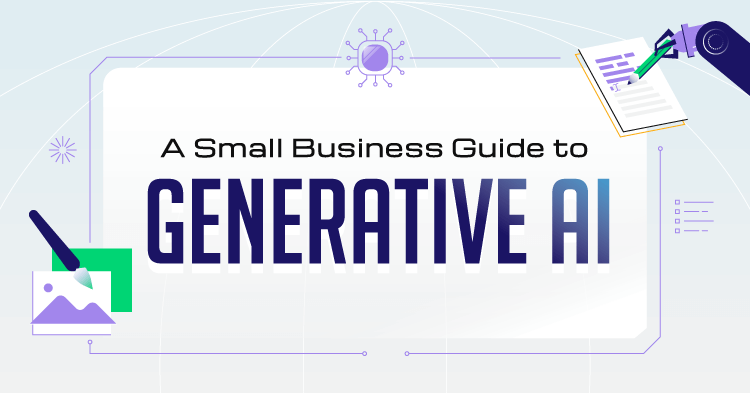Generative AI for Small Businesses: Uses, Tools and Examples
The present wave of generative AI technology struck the business world hard and fast.
Since unveiling its DALL-E 2 image-generating software in the summer of ’22, OpenAI and its rival big AI developers have driven the technology forward in a so-called “arms race.” At the same time, established tech giants pursue a “land grab.” Meanwhile, smaller indie developers echo the trend, turning out countless new AI-powered apps and services daily, hoping to dominate their corner of the market. Everyone else looks on, trying to figure out what has changed and what is next.
The panicky language used to describe the past 18 months is understandable. Overnight, generative AI bots have popped into everyday use, promising to complete creative tasks and administrative chores in an instant with just a brief, natural language prompt. People aren’t sure if they’re next to lose their jobs or if they should already be benefiting more from what these tools have to offer.
But this panic is also a symptom of the hype. Cut both away, and small business owners are confronted with simple, powerful tools for executing complex tasks in a minimal timeframe. And sure, embracing generative AI at work takes a change of habit and a bit of learning. But AI tools are built to be both intuitive and actively helpful. That is part of their power.
We want to demystify generative AI and lay out how it can become an effective part of the daily life of a small business. So, we created a comprehensive guide on using AI-generated text, images, audio and video in the workplace.
What is Generative AI?
Accessed through online apps and websites, generative AI tools draw on massive banks of data to analyze existing materials and create seemingly original text, images and other media.
The simplest existing material that a user can supply is called a “prompt.” A prompt can be as straightforward as a few words in your usual pattern of speech, or it can be a more considered set of instructions. You can pair a written prompt with existing research for analysis or with images or video as a point of reference. And with some services, you can maintain a conversation with the AI as you develop whatever you’re trying to create — be it a business email, a marketing image or a how-to video.
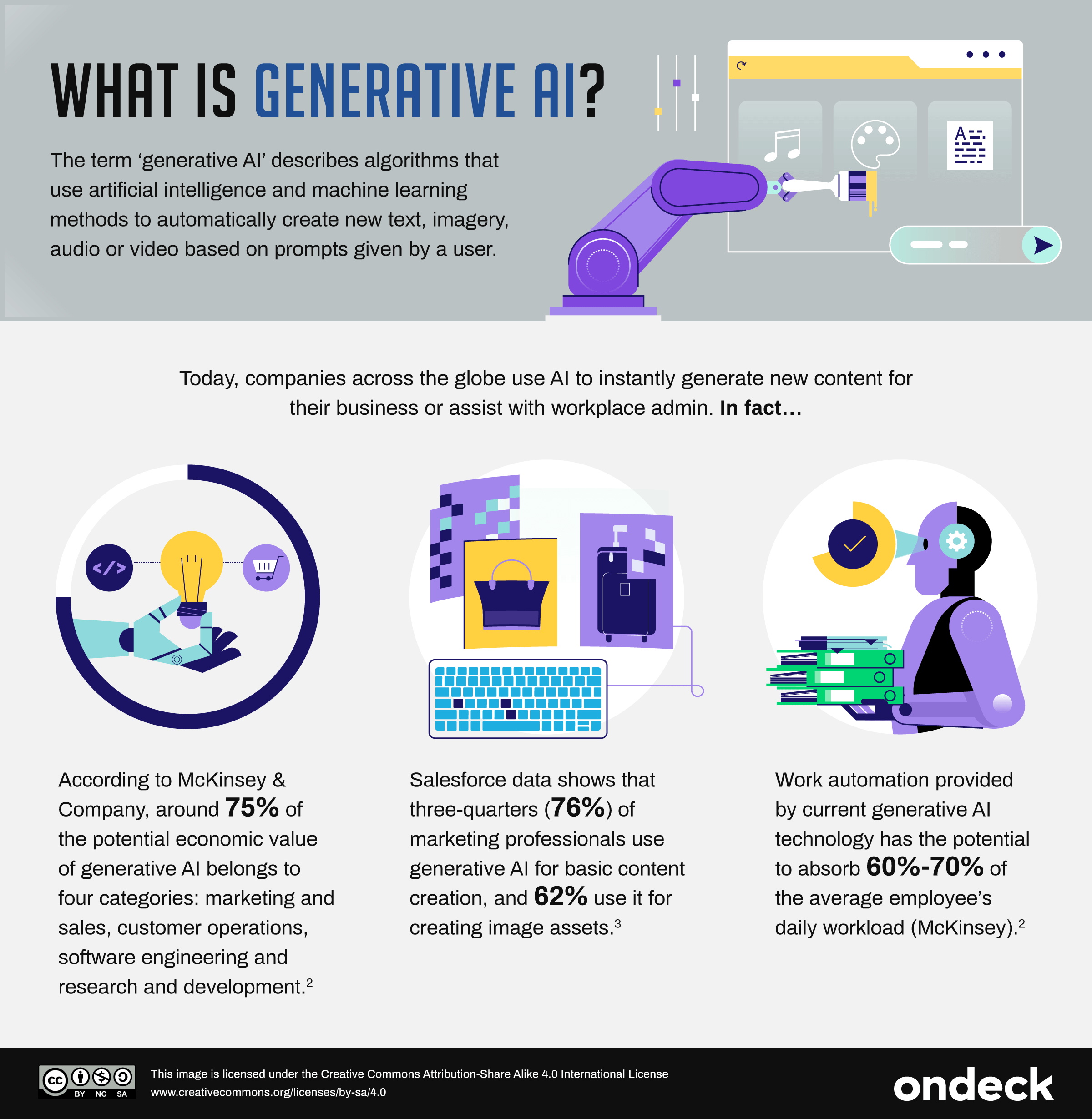
Click here to see the image in full size
It is now more common for AI apps to have web access, making the technology increasingly useful for effective web search and analysis. And while the big companies have launched flagship services such as ChatGPT or Google Bard based on their own machine learning technology, they have also made their underlying engines accessible for third-party developers to create their own tools. These tools might offer industry-specific analysis, media production shortcuts or personalized chatbots for your website, for example.
Some experts have suggested that AI will prove as transformative as the arrival of the internet or that “the AI Revolution will be as huge as the Industrial Revolution.” Economists at the Boston Consulting Group are more cautious, asking, “Does it have the same ‘general purpose’ application in the economy that the internet had?” Their answer: “Perhaps one day it will, but likely with long lags.” While there’s clearly a great deal of potential for small businesses, owners do not need to panic.
What Business Owners Need to Know About Generative AI
Some 97% of business owners believe that OpenAI’s ChatGPT can be helpful at work, according to a Forbes survey, and 64% “believe AI will improve customer relationships.” But in that same Forbes survey, 40% of bosses expressed concerns “about an over-dependence on technology due to AI use” — and this is just one caveat that business owners should keep in mind when embracing the technology.
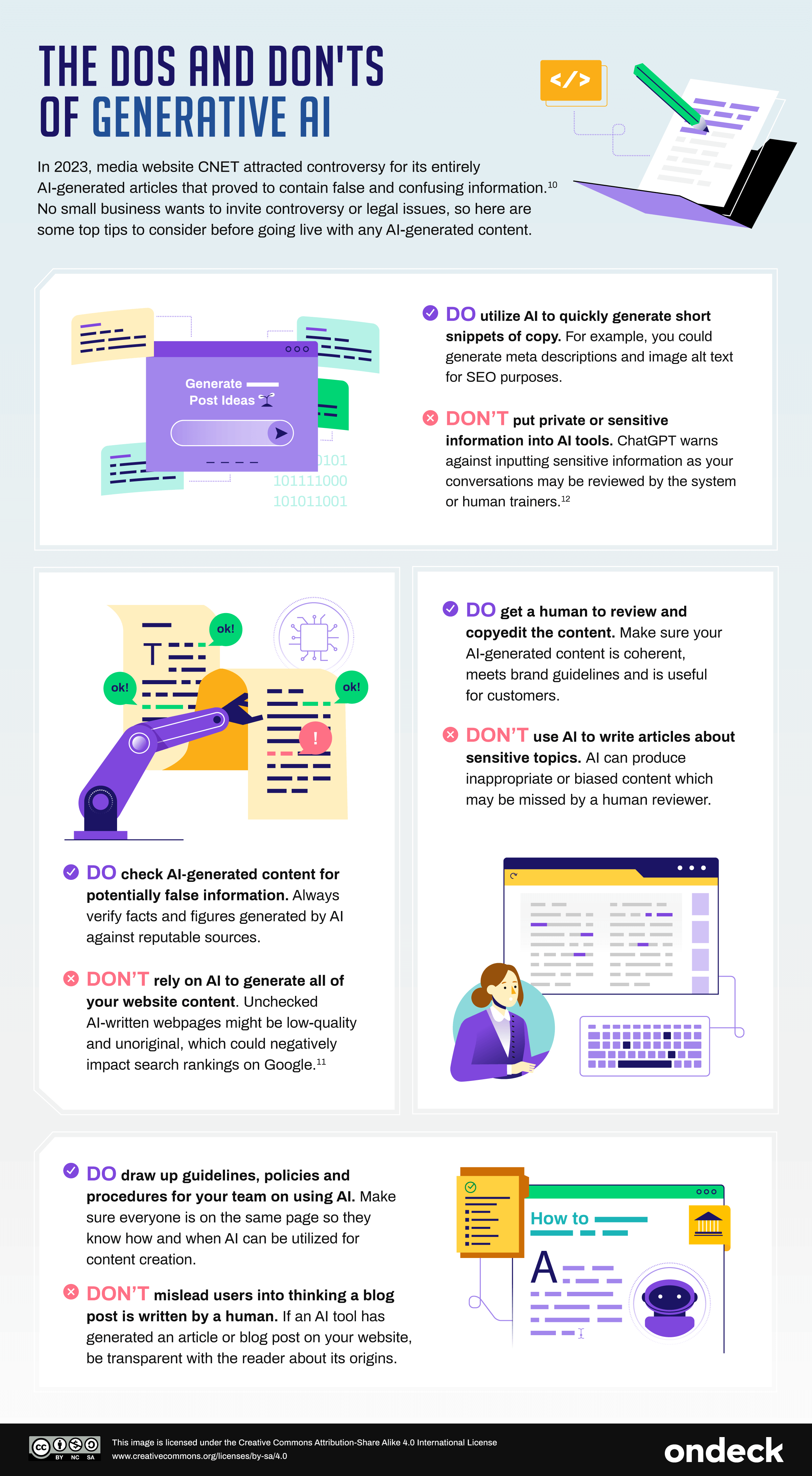
Click here to see the image in full size
One of the main concerns with generative AI as a tool is that its power can be deceptive. It’s relatively easy to churn out pages of convincing-sounding text or a set of eye-grabbing images with these tools. But AI is not human. Generative AI uses algorithms to “predict” the answer you need, drawing information and patterns from imperfect data sets. Even the best tools exhibit inherent bias and make frequent mistakes. If a business shares or acts upon flawed AI materials, it is the business that will be held accountable, not the tool.
How to Use Text Generation AI in a Small Business
AI text generators are trained on vast datasets to learn the grammar and style of natural language writing. The user can enter a simple or detailed prompt, from which the text generation AI will deduce a pattern to follow, “predicting” the best words to use one after another.
While tools such as ChatGPT were initially hampered by a cut-off date in their knowledge, today, many such apps and platforms can access the web. This makes it relatively simple to produce emails or simple blog posts using up-to-the-minute context or get detailed answers to your own queries for in-house use.
It’s worth noting that although Google doesn’t automatically push AI-written articles lower down in search results, it does penalize lower-quality content. And AI text may be considered low-quality if it lacks the originality and uniqueness that a flesh-and-blood writer brings. Of course, the more work you do on the human end to identify keywords and create a structure and a powerful set of prompts, the higher the output quality will be.
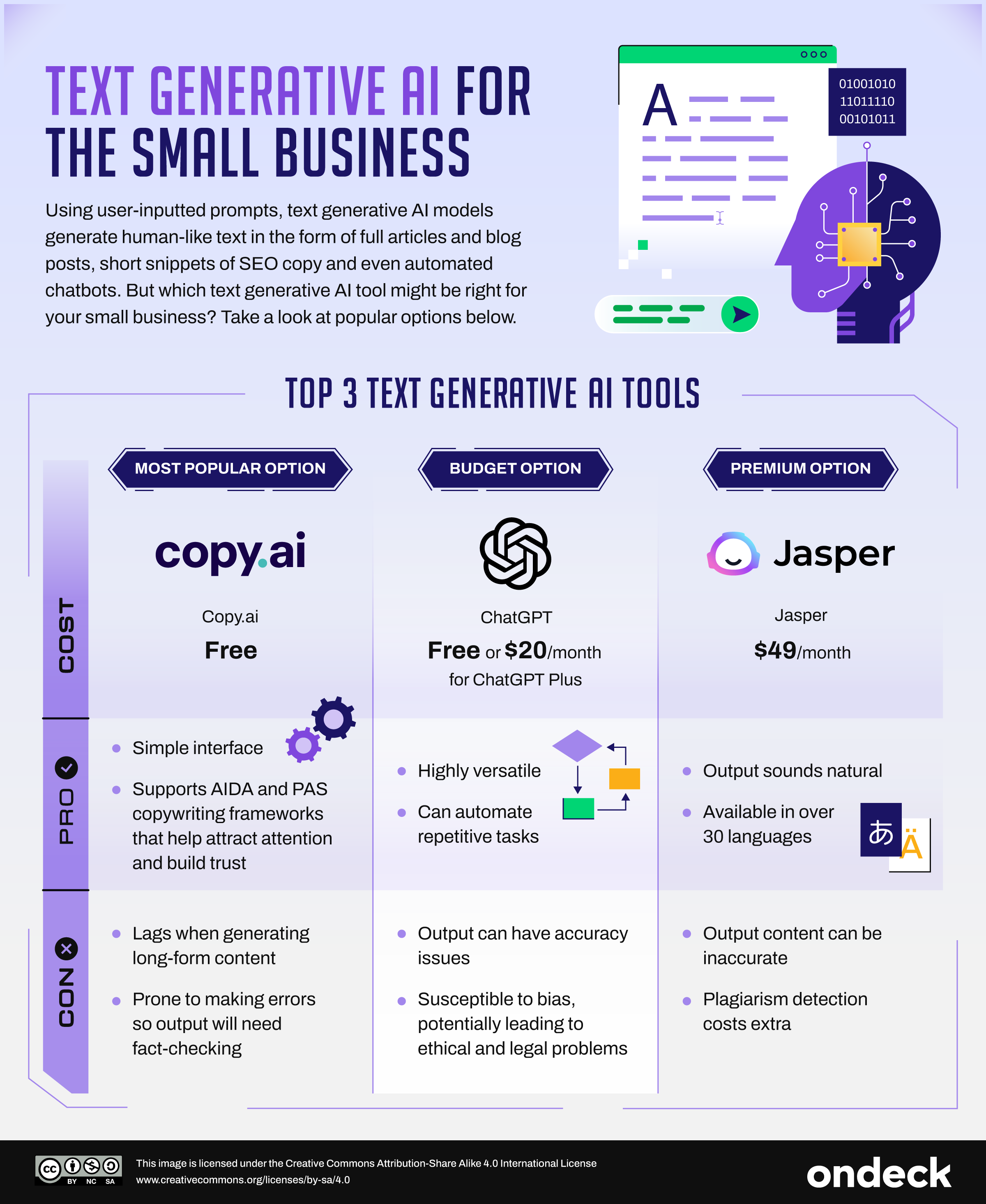
Click here to see the image in full size
We identified some pros and cons of three of the leading text generative AI tools below. They all use OpenAI’s underlying GPT (essentially its brain), although Copy.ai is “model-agnostic” and “designed to work with various AI models like GPT 3.5, GPT 4, Azure, Anthropic and more.” This means, among other things, that you can continue to use Copy.ai if OpenAI suffers an outage.
OpenAI rushed out its ChatGPT service in November 2022 to create a user-friendly face for its powerful AI engines. The company has improved ChatGPT on the fly, and it has become a versatile tool that is particularly strong at conversation and returning/re-tuning quick requests. Jasper and Copy.ai use software built on these foundations but tuned to excel in specific sales and marketing use cases. All these services are liable to make factual errors, and a human should check their work before publishing.
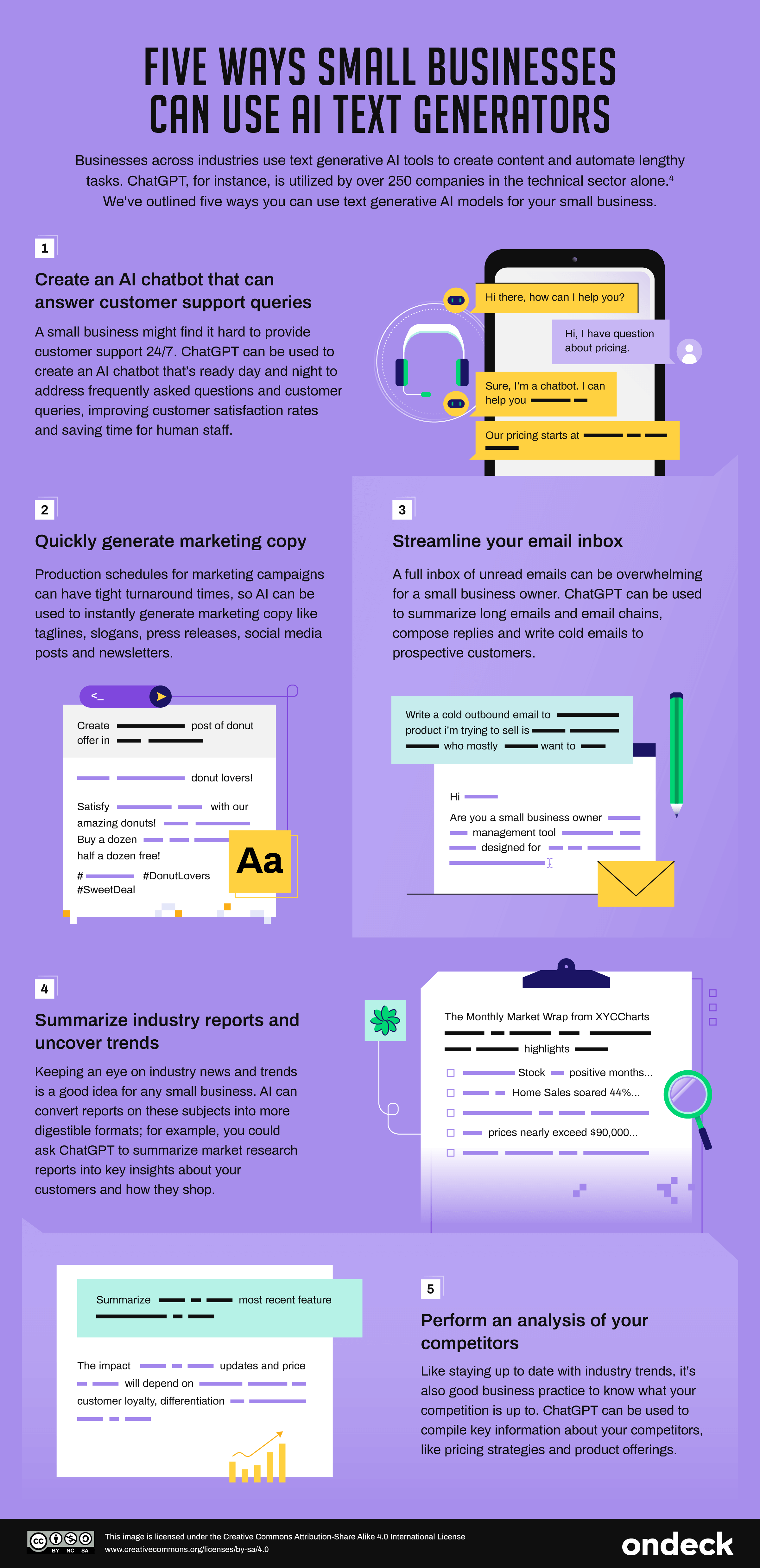
Click here to see the image in full size
How to Use Image Generation AI in a Small Business
The growing power of generative AI first caught the wider public’s eye on the release of DALL-E 2 and Midjourney in the summer of 2022. Impressive images created without the prerequisite of any artistic or design talent began doing the rounds on social media and the online press. Many of these images would be difficult, time-consuming or expensive to create, even with talent. This forced the companies behind the software to release consumer versions sooner than they’d planned, to capitalize on the hype and avoid falling behind in the market.
Now, anybody can create logos, illustrations and other website imagery by entering a simple text prompt. You can do this via a website (OpenAI’s DALL-E 2, Stability AI’s Stable Diffusion) or the social media app Discord (Midjourney — although browser-based prompting will likely be available soon).
Since the software was rushed out ahead of schedule, it can take a few attempts to create a complex image that suits your needs and is error-free (we’ve all seen the nightmare hands!). Some established imaging tools, such as Adobe Photoshop, now have AI capabilities built in — which gives you more control if you are familiar with such software to start with.
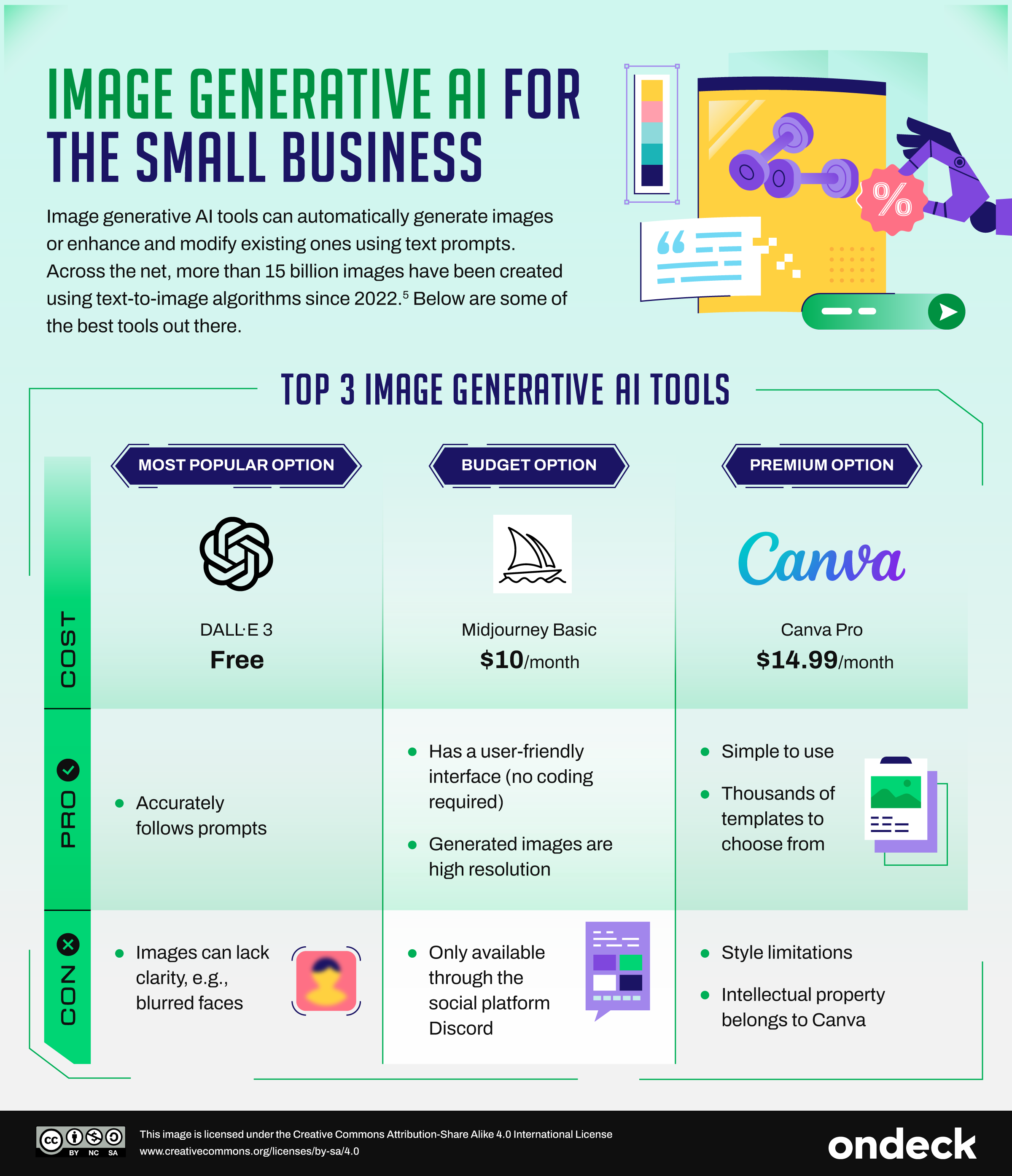
Click here to see the image in full size
The newest of the three top image generative AI tools below is DALL-E 3. OpenAI says this update offers “significantly more nuance and detail” than DALL-E 2 and interprets instructions more accurately. For now, DALL-E 3 is only available through the ChatGPT interface. However, this means you can chat with the software and guide it through successive versions of your image until you get what you need.
Midjourney is often considered the best AI tool for creating realistic images out of the box. And Canva is the most versatile and user-friendly of the bunch. Canva was built to allow people to create graphics with minimal design knowledge. Now that it has AI capabilities, Canva can read a prompt and use it to generate text, imagery and templates, which the user can adjust and edit using natural language or a simple drag-and-drop interface.
It is worth noting that while you don’t need design skills to create usable images using AI, an experienced human designer will have a firmer grip on the design principles at play. They are more likely to notice issues that can affect viewers subconsciously and will bring a livelier visual imagination to play from the start — even if you hire them to work with image generation AI.
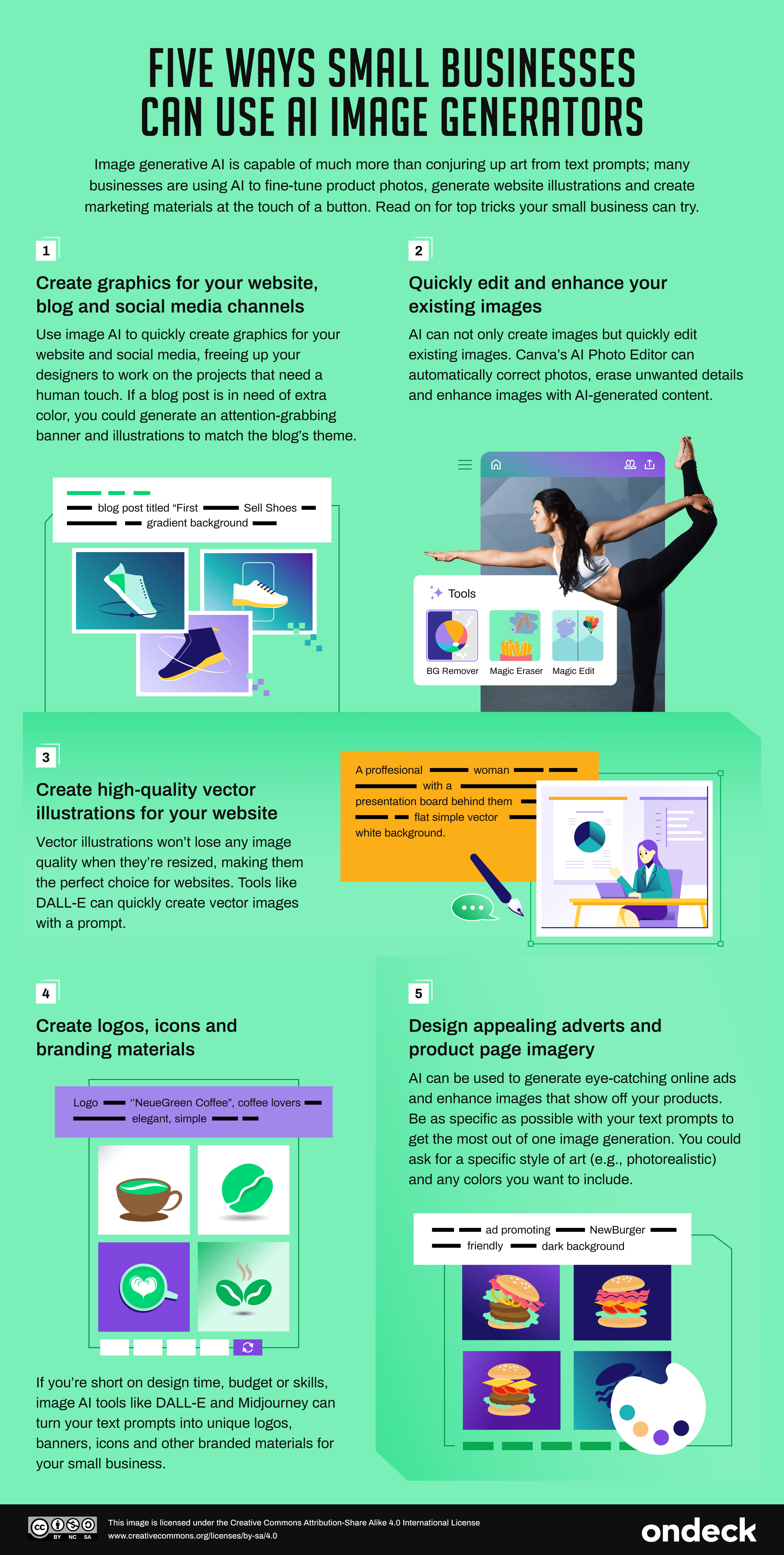
Click here to see the image in full size
How to Use Audio Generation AI in a Small Business
The primary uses of audio generation AI tools veer in opposite directions:
- Text-to-audio tools make it easy to create podcasts, marketing clips or music from written materials such as rough notes, blog posts or simple prompts.
- Audio-to-text tools offer transcription capabilities, taking meeting notes in real time, which the tool can then use to formulate organized notes.
But that’s not all. A third option is to use AI to edit or modulate audio material. Adobe Podcast AI offers to create the “perfect balance of studio-quality and natural environment sound.” Other tools promise to quickly remove silences or automatically cut ums, ahs and other unwanted vocal sounds.
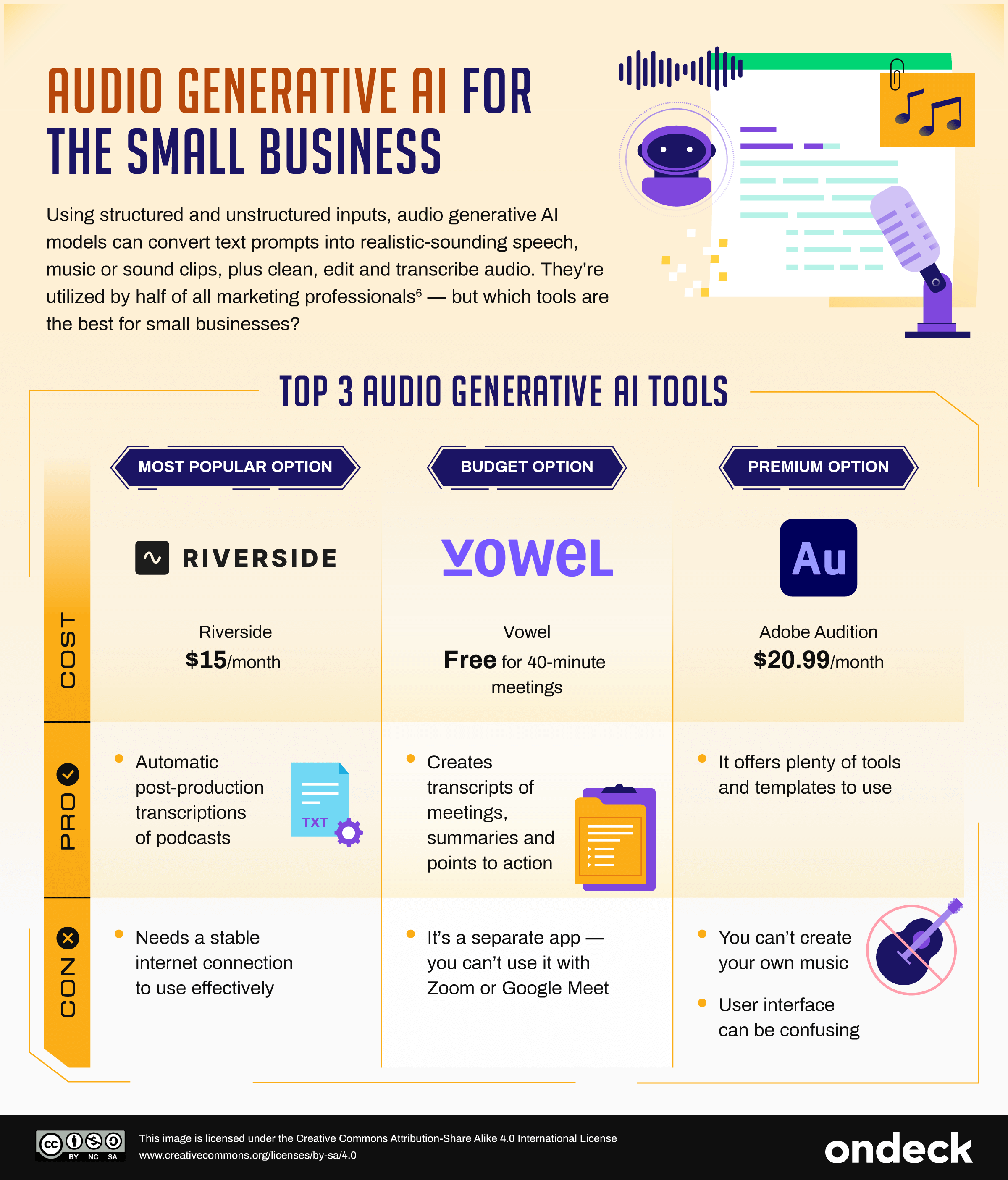
Click here to see the image in full size
We’ve identified three powerful options for audio generation AI below. At $15 per month, Riverside is a professional-grade tool for regular home podcasters. Riverside was established in 2020 and offers an online audiovisual studio for creating professional-quality podcasts. It provides up-to-the-minute AI capabilities for audio editing and can transcribe recordings in over 100 languages.
Vowel is a conferencing tool positioned as an alternative to Zoom. The free version offers automatic transcription of your online meetings, which you can use to navigate recordings and quickly get back to the moment you need. The business plan offers meeting summaries and can even sum up the “meeting so far” for latecomers, mid-meeting. Vowel also lets users interrogate a Q&A bot for details about the meeting notes.
Finally, Adobe Audition is a more established piece of desktop software used for professional audio recording, editing and mixing. As part of Adobe Experience Cloud, Audition benefits from Adobe Sensei GenAI, a virtual “co-pilot” that integrates AI generation into Adobe’s creative tools. For now, this means Auto-Ducking (adjusting sound levels to keep the important parts prominent) and audio restoration features, though more AI audio features are sure to come.
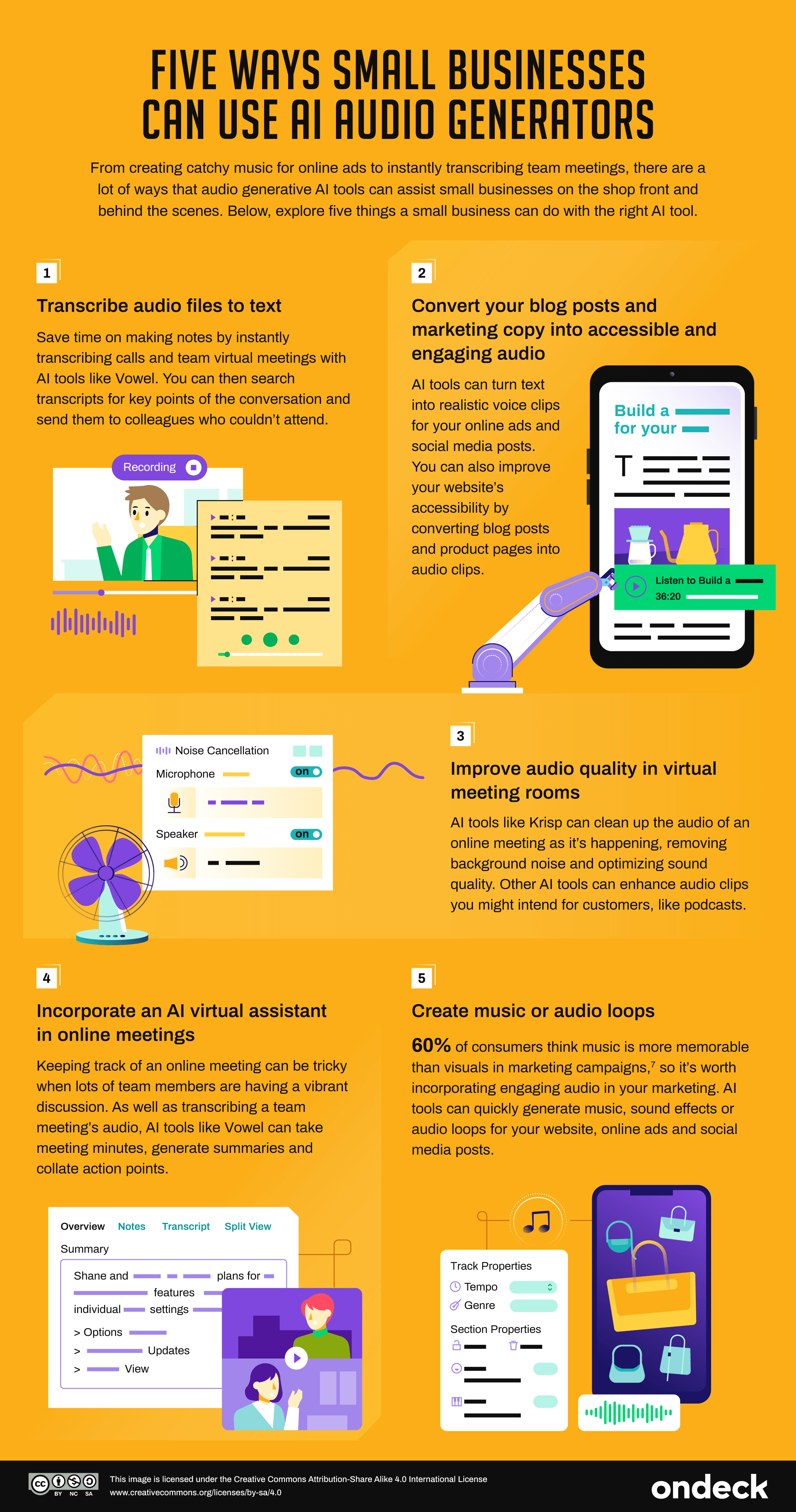
Click here to see the image in full size
How to Use Video Generation AI in a Small Business
The internet is “a video-first medium now,” says IT and web culture consultant Ryan Broderick, “…and if you want to build up an account quickly in 2023, which in turn helps you promote the content you’re making online, then the easiest way to do that is with video.”
However, video is a complex art. It requires text, image and audio skills in addition to the moving image’s own unique requirements. As such, it can be intimidating and time-consuming to get started. Since text-to-video prompting isn’t quite there yet, the most effective video generation tools take care of the constituent tasks of filmmaking to power up your production game.
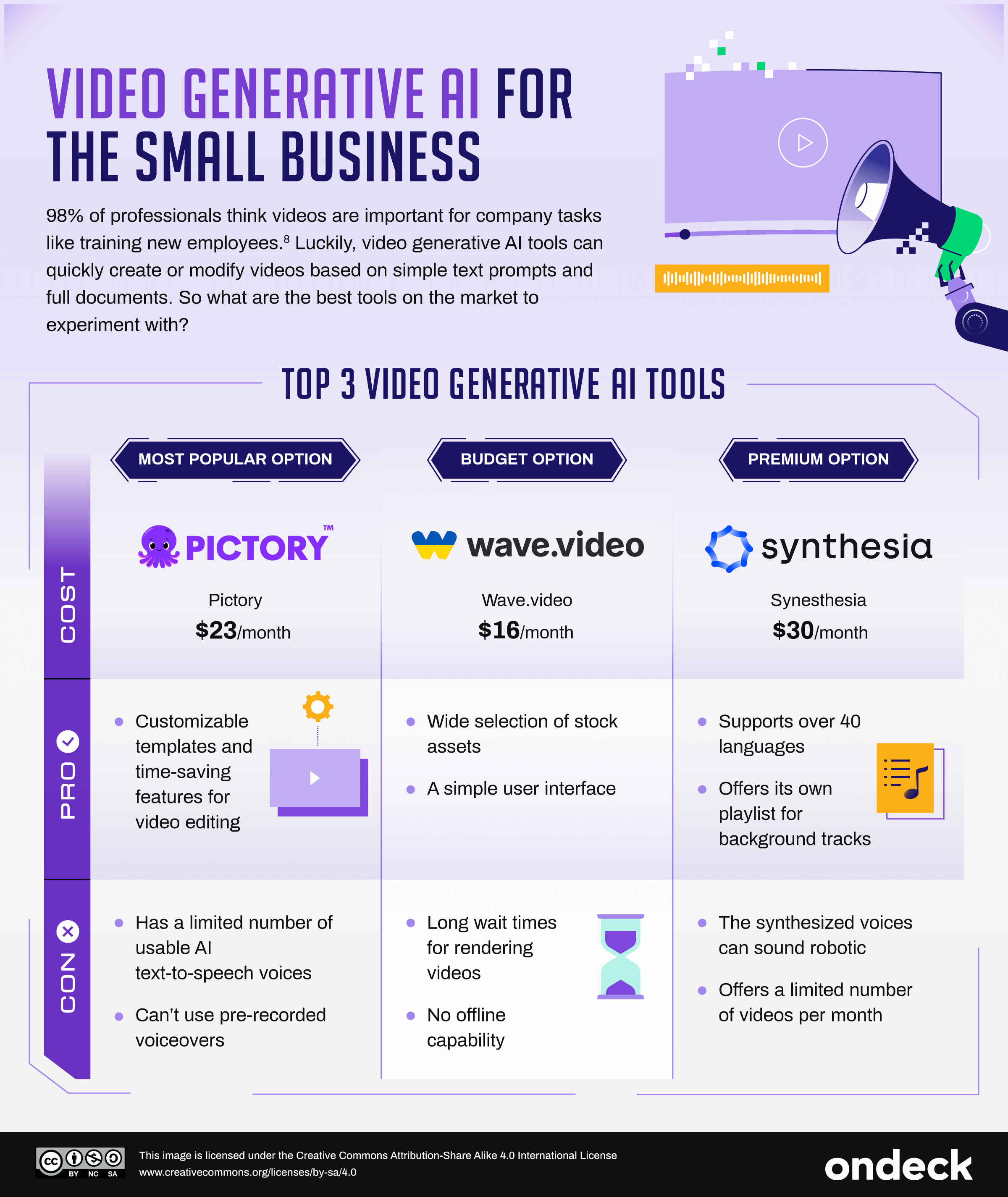
Click here to see the image in full size
For example, rather than generate original footage, Pictory automatically assembles a film from your script using stock footage and music and AI-generated voiceovers. If you don’t have a script, the software prepares a structure and voiceover from whatever you give it — ideally, a blog post or article.
Wave.video is a similar service with a solid set of templates and stock elements. Wave.video’s strengths are in its visuals and editing capacities, while Pictory might be the better choice if you need more support with script and structure.
Synthesia costs a bit more but boasts the most promising generative video features of the three, offering realistic, AI-generated human avatars in place of real-life presenters. This feature is integrated into an intuitive editing interface that requires little to nothing in the way of prior video experience — although, as with the text, image and sound tools above, experienced professionals will bring added expertise to the job.
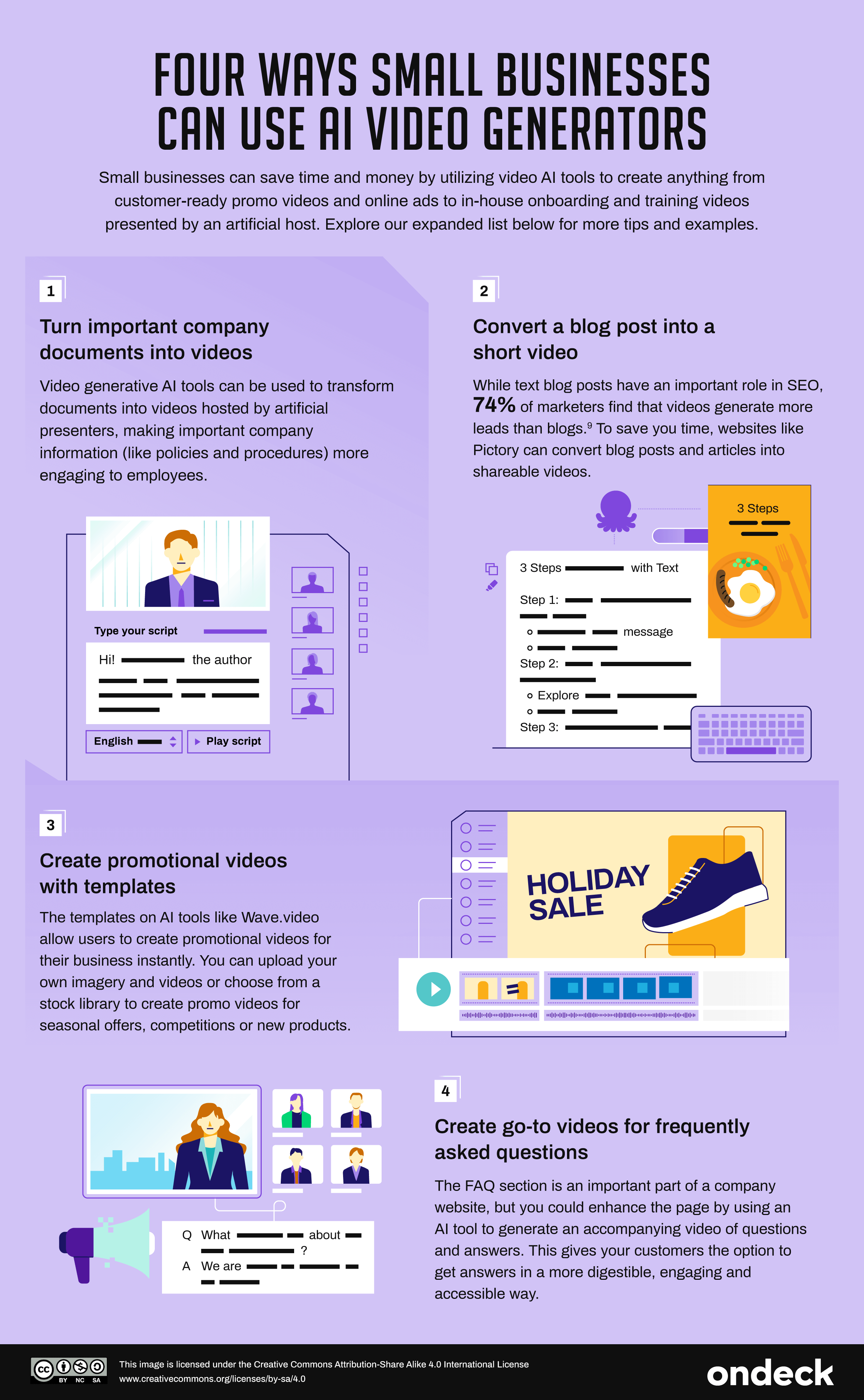
Click here to see the image in full size
A Step-By-Step Guide to Powering Up Your Small Business with AI
IBM’s Rob Thomas suggests that the unveiling of ChatGPT in 2022 was AI’s “Netscape moment” — echoing the introduction of the first web browser in 1994, which “brought the internet alive” for the general public.
In fact, the internet has existed in some form since 1983. This reminds us that AI development has been much slower than it appears and that it will take some time to figure out what it means for business and the wider world.
So, small business owners don’t need to panic about missing the AI revolution — but it makes sense to start getting to grips with the concepts and software today. The tools outlined above and others like them are designed to make powerful marketing and communication techniques accessible to non-experts. Entrepreneurs who find the tools that work for them and integrate them into newer, faster workflows will find themselves surfing the new wave instead of chasing it.

Click here to see the image in full size
Sources
- McKinsey Digital. (2023). The state of AI in 2023: Generative AI’s breakout year. mckinsey.com
- McKinsey Digital. (2023). The economic potential of generative AI: The next productivity frontier. mckinsey.com
- Salesforce. (2023). Top Generative AI Statistics for 2023. salesforce.com
- Thormundsson, B. (2023). Amount of companies using ChatGPT in their business function in 2023, by industry. statista.com
- Everypixel Journal. (2023). AI Has Already Created As Many Images As Photographers Have Taken in 150 Years. Statistics for 2023. journal.everypixel.com
- Botco.ai. (2023). The State of GenAI Chatbots in Marketing. botco.ai
- PHMG. (2023). Sonic identity development. phmg.com
- Kasparova, K. (2023). 20 (AI) Training Video Stats You Need to Know In 2023. synthesia.io
- Greene, J. (2022). Blogging vs. Video: When Does Each Format Work Best? databox.com
- Farhi, P. (2023). A news site used AI to write articles. It was a journalistic disaster. washingtonpost.com
- Sullivan, D. Nelson, C. (2023). Google Search’s guidance about AI-generated content. developers.google.com
- Natalie. (2023). What is ChatGPT? help.openai.com
DISCLAIMER: This content is for informational purposes only. OnDeck and its affiliates do not provide financial, legal, tax or accounting advice. OnDeck has no relationship or affiliation with any of the businesses or services mentioned, and nothing herein should be viewed as a recommendation or endorsement.
